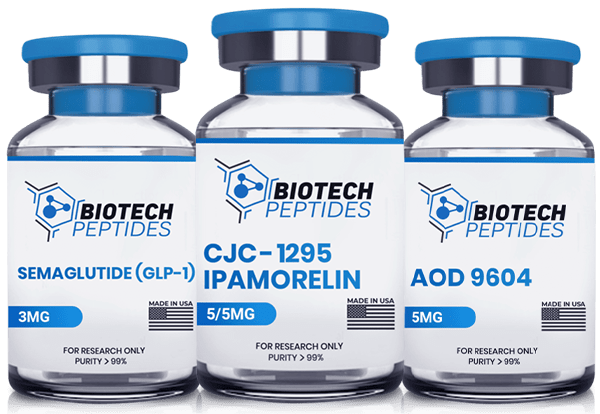
Ipamorelin Peptide – Blend Comparison Research
The present discourse concerns the evaluation of Ipamorelin, a growth hormone-releasing peptide (GHRP) that has recently received increasing attention. The extant body of literature suggests that Ipamorelin may elicit a rise in growth hormone (GH) concentrations [i].
This article aims to provide comprehensive information on Ipamorelin, including its mechanism of action, potential properties, associated hazards, and optimal procurement sources. All information presented in this article is strictly aimed toward licensed professionals and scientists. None of the research compounds have been approved for human consumption, and their ingestion is strictly prohibited.
Trending Now!!:
Ipamorelin Peptide and the Growth Hormone Secretagogue Class.
The compound known as Ipamorelin is a pentapeptide consisting of Aib-His-D-2-Nal-D-Phe-Lys-NH2. As suggested by previous research, it may exhibit a notable potency and efficacy in releasing growth hormones in vitro.
Research suggests the substance in question may exhibit a comparatively prolonged half-life duration of 1.5-2.5 hours as opposed to GHRP-2, which has a half-life of 25-55 minutes. In contrast to GHRP-2 and GHRP-6, which have been speculated to promote lean mass gain [i], presenting the substance above has been associated with overall weight gain.
Ipamorelin Peptide Mechanism of Action
Ghrelin is an endogenous hormone synthesized by enteroendocrine cells located in the gastrointestinal tract, with a primary source in the stomach. As mentioned above, the statement denotes the binding of a certain entity to the receptor of growth hormones secretagogue, commonly known as GHS-R1a.
The GHSR1a is predominantly expressed in the AgRP/NPY neurons of the hypothalamus within the brain. The GHSR1a expression is primarily observed in the hippocampus and dopaminergic midbrain neurons within extrahypothalamic regions. They are present in adipocytes, cardiomyocytes, and osteoblasts within peripheral tissues and are considered crucial in maintaining glucose-insulin homeostasis, gastrointestinal motility, cardiovascular health, inflammation, and tissue growth and repair [iii].
Research suggests Ipamorelin may exhibit selective binding to the GHSR-1a receptor, which GHRP-2, GHRP-6, and Ibutamoren also allegedly target through its ability to mimic ghrelin [i]. The engagement of GHSR-1a results in the secretion of GH from the pituitary gland, thereby exerting an impact on various anabolic mechanisms such as the modulation of appetite, lipid metabolism, and global energy homeostasis [i].
The studies suggest the presentation of GHRP-6 and GHRP-2 may have elicited elevated levels of ACTH and cortisol in the plasma. Remarkably, the presentation of Ipamorelin did appear to result in a significant difference in the release of ACTH or cortisol levels compared to the levels observed after GHRH stimulation, researchers speculate [ii].
Ipamorelin Peptide Properties
Studies suggest the principal outcome of Ipamorelin’s presentation may be the elevation of growth hormone (GH) levels in the bloodstream. The alterations observed in the test models’ physical structure appear to be consequences of heightened levels of growth hormone (GH) in the bloodstream.
Scientists hypothesize Ipamorelin may facilitate a seamless recovery phase. Studies suggest that this process effectively promotes the repair of damaged muscle fibers and stimulates the growth of new ones.
Ipamorelin has been speculated to facilitate expedited and enhanced wound and injury healing using the targeted delivery of growth hormone (GH) to the affected site, thereby stimulating the proliferation of new cells.
Prior research on animals has suggested that Ipamorelin may enhance bone mineral content (BMC) in female rats of young adulthood [iv].
The presentation of Ipamorelin has been suggested to increase growth hormone (GH) levels, which may contribute to improved sleep quality characterized by deeper stages. The secretion of GH during sleep is believed to be predominantly reliant on the discharge of growth hormone-releasing hormone. Studies conducted on rodents have implied that growth hormone-releasing hormones may reduce wakefulness and enhance slow-wave sleep (SWS) [v].
As organisms age, there is a gradual decrease in GH secretion, estimated at around 15% for each subsequent decade of full maturity [vi]. Research suggests Ipamorelin may exert a stimulatory effect on the endogenous production of growth hormones.
Ipamorelin Peptide vs. Sermorelin Peptide
Studies suggest the primary disparity between the two peptides lies in their respective mechanisms of action.
Researchers speculate both peptides may induce an increased secretion of growth hormone (GH); however, Ipamorelin may exhibit binding affinity towards growth hormone secretagogue receptors (GHSR) situated in the hypothalamus and peripheral organs, whereas Sermorelin may selectively bind to growth hormone-stimulating hormone receptors (GHSHr) located solely in the hypothalamus.
Ipamorelin Peptide vs. CJC-1295 Peptide
Researchers suggest these peptides are frequently studied in combination. Studies suggest Ipamorelin may exhibit a rapid onset of action, whereas CJC-1295 necessitates 1 to 4 hours to manifest action in animal test models. The duration of Ipamorelin’s half-life is shorter than that of CJC-1295. For more peptide information, visit this website.
References
- Sinha DK, Balasubramanian A, Tatem AJ, Rivera-Mirabal J, Yu J, Kovac J, Pastuszak AW, Lipshultz LI. Beyond the androgen receptor: the role of growth hormone secretagogues in modern body composition management in hypogonadal males. Transl Androl Urol. 2020 Mar;9(Suppl 2):S149-S159. doi: 10.21037/tau.2019.11.30. PMID: 32257855; PMCID: PMC7108996.
- Raun K, Hansen BS, Johansen NL, Thøgersen H, Madsen K, Ankersen M, Andersen PH. Ipamorelin, the first selective growth hormone secretagogue. Eur J Endocrinol. 1998 Nov;139(5):552-61. doi: 10.1530/eje.0.1390552. PMID: 9849822.
- Gross JD, Kim DW, Zhou Y, Jansen D, Slosky LM, Clark NB, Ray CR, Hu X, Southall N, Wang A, Xu X, Barnaeva E, Wetsel WC, Ferrer M, Marugan JJ, Caron MG, Barak LS, Toth K. Discovery of a functionally selective ghrelin receptor (GHSR1a) ligand for modulating brain dopamine. Proc Natl Acad Sci U S A. 2022 Mar 8;119(10):e2112397119. doi: 10.1073/pnas.2112397119. Epub 2022 Mar 3. PMID: 35239443; PMCID: PMC8915830.
- Svensson J, Lall S, Dickson SL, Bengtsson BA, Rømer J, Ahnfelt-Rønne I, Ohlsson C, Jansson JO. The GH secretagogues ipamorelin and GH-releasing peptide-6 increase bone mineral content in adult female rats. J Endocrinol. 2000 Jun;165(3):569-77. doi: 10.1677/joe.0.1650569. PMID: 10828840.
- Van Cauter E, Plat L. Physiology of growth hormone secretion during sleep. J Pediatr. 1996 May;128(5 Pt 2):S32-7. doi: 10.1016/s0022-3476(96)70008-2. PMID: 8627466.
- Garcia JM, Merriam GR, Kargi AY. Growth Hormone in Aging. [Updated 2019 Oct 7]. In: Feingold KR, Anawalt B, Blackman MR, et al., editors. Endotext [Internet]. South Dartmouth (MA): MDText.com, Inc.; 2000-. Available from: https://www.ncbi.nlm.nih.gov/books/NBK279163/


